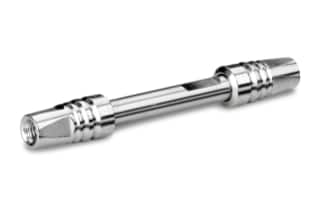
|
Chemistry |
C8 |
|
Separation Mode |
Reversed Phase |
|
Particle Substrate |
Hybrid |
|
pH Range Min |
1 pH |
|
pH Range Max |
12 pH |
|
Maximum Pressure |
18000 psi (1240 Bar) |
|
Endcapped |
Yes |
|
Silanol Activity |
Low |
|
Particle Shape |
Spherical |
|
Particle Size |
1.7 µm |
|
Endfitting Type |
Parker-style |
|
Pore Size |
130 Å |
|
Format |
Column |
|
Surface Area |
185 |
|
System |
UPLC, UHPLC |
|
Particle Technology |
BEH |
|
USP Classification |
L7 |
|
Inner Diameter |
2.1 mm |
|
Length |
50 mm |
|
Carbon Load |
13 % |
|
eCord |
Yes |
|
UNSPSC |
41115709 |
|
Brand |
ACQUITY UPLC |
|
Product Type |
Columns |
|
Units per Package |
3 pk |

ACQUITY UPLC BEH C8 Column, 130Å, 1.7 µm, 2.1 mm X 50 mm, 3/pk
With the most technologically advanced LC column products ever created, the ACQUITY UPLC column family is designed, tested, and guaranteed for use in applications up to 15000 psi (1000 bar). This is done while offering unprecedented efficiency, ruggedness, and throughput for a range of separations. ACQUITY UPLC BEH C8 Columns incorporate the trifunctional ligand bonding chemistries used in this range of lab equipment, producing superior low pH stability and ultra-low column bleed.
This low pH stability is combined with the high pH stability found in the 1.7 µm BEH particle, allowing the ACQUITY UPLC BEH C8 Column to deliver the widest usable pH operating range. Additionally, this chemistry uses a new and proprietary end-capping process that allows for the best peak shape for bases. The combination of these chemistries and particle synthesis produce the sharpest peaks, highest efficiencies, and maximum MS sensitivities.
The ACQUITY BEH C8 sorbent used in these columns is less retentive when compared with the ACQUITY BEH C18 sorbent. Method developers may prefer the speed characteristic of these less retentive columns, which also improve peak shape and chromatographic performance. C8 sorbents bonded stationary phases maintain the stability, retentivity, and reproducibility expected in reversed-phase LC separations, while hydrophobic ligands provide the desired separation.
As a part of the ACQUITY UPLC family of columns, lifetimes on the ACQUITY UPLC BEH C8 Column can be further extended with the use of a VanGuard Pre-Column. The ACQUITY UPLC BEH C8 VanGuard Pre-column, 130Å, 1.7 µm, 2.1 mm X 5 mm, 3/pk is uniquely designed to protect and prolong these columns’ performance while contributing minimal chromatographic effects in the process.
Why Does The Particle Size Of A Column Matter?
Particle size refers to the mean diameter of the spherical supports used to pack a column. This is a physical dimension that is known to impact column performance. As the particle size decreases, the curve of a chromatographic peak becomes flatter and less impacted by higher column flow rates. Selectivity, retention capacity, and efficiency are all impacted by the particle size as it is larger or smaller. Particle size is often measured in micrometers, or µm, which is equivalent to one-millionth of a meter. For reference, a single human hair ranges from 20 to 200 µm in width.